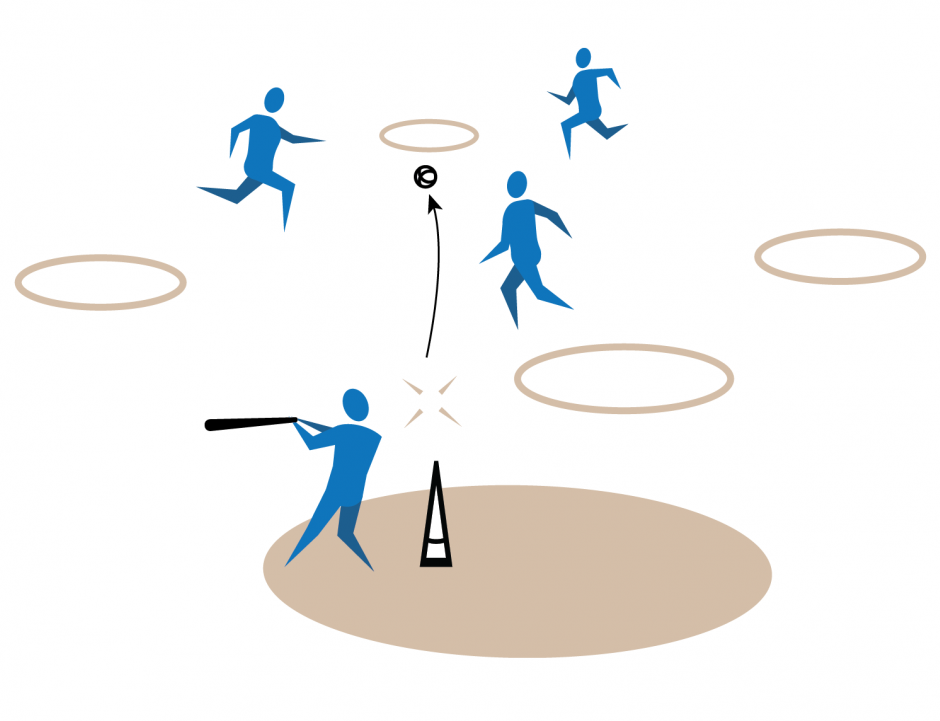TGfU Category: Striking/Fielding Games
Locations: gymnasium, outdoor space (e.g., field, tarmac)
Game/Sport Connections
Striking/fielding games are activities in which players score points by striking an object and move to designated playing areas or prevent opponents from scoring by retrieving the object and returning it to stop the play. By playing these games, participants develop skills and tactics to play other striking/fielding games or games that require the application of similar skills, concepts, and strategies (e.g., baseball, cricket, rounders, softball).
Activity Overview
Participants learn about and practise using an implement to strike an object at targets in the activity area.
Key Movement Skills, Concepts, and Strategies
Throughout the activity, consider highlighting the following skills, concepts, and strategies to help participants strike and field an object. Note that this list is not exhaustive and further learning opportunities may arise during the task.
Movement Skills and Concepts
- Manipulation skills and effort awareness: applying a controlled force to use an implement to strike an object into targets different distances away.
- Body awareness: being aware of body position when striking an object (e.g., standing sideways facing the object with feet slightly wider than shoulder width apart with most of the body weight on the back foot, shifting body weight from back foot to front foot while moving toward an object).
Movement Strategies
Understanding and developing tactics to strike an object into targets to accumulate points (e.g., choosing the target worth the most points, choosing the target they will be most successful at hitting).
Considerations
- Incorporate some or all of the variations listed in the “Variations” section while planning the activity. This will help to best meet the diverse backgrounds, identities, needs, and interests of participants and maximize the fun, inclusion, participation, and success of everyone.
- To elevate participant voice and choice, periodically pause the activity and share the variations with participants. Ask them to determine how they would like to change the activity to maximize the fun, inclusion, meaningful participation, and success for everyone. Encourage participants to add any variations of their own.
Equipment
- 1 ball per group (soft ball, beach ball, foam tennis ball)
- 1 tee or large pylon per group
- 2 – 3 implements for striking per group (e.g., rubber bats, racquets, lollipop foam paddles)
- 4 hula hoops per group
- 4 small objects per group (e.g., beanbags, rubber/vinyl spots, flat discs) (optional)
Safety
- Inspect the equipment and activity area to identify and remove hazards. Check that the activity surface provides sufficient traction.
- Establish the boundaries for the designated playing area at a safe distance from walls and obstacles. Share the boundaries with participants.
- Review the safety rules and activity instructions with participants prior to the activity.
- Instruct participants to be aware of their surroundings, including the locations of other participants during play.
How to Play
- Divide participants into pairs or small groups (e.g., 3 – 4).
- Groups set up their playing area by placing a tee or pylon to one side of their activity area with a ball of their choice on top.
- Groups place 4 hula hoops at various distances in front of their tee or pylon with an object inside their hoop (e.g., beanbag, rubber/vinyl spot, flat disc). The playing area may be increased or decreased based on participants’ needs and available space. Ensure there is a safe distance between groups.
- Groups determine how many points each target is worth. Guide participants to consider allocating more points to the targets that may be more challenging to hit (e.g., beanbags = 10 points, rubber/vinyl spots = 5 points, flat discs = 2 points).
- Provide groups with 2 – 3 implements for striking.
- Groups divide up, with 1 participant, the batter, starting at-bat while the remaining participants in the group are in the outfield retrieving the hit ball and returning it to their tee or pylon.
- The first batter chooses an implement for striking (e.g., rubber bat, racquet, lollipop foam paddle) to hit the ball off the tee or pylon toward one of the hula hoops. Participants may also use their hand to strike the ball.
- If the ball lands inside a hoop, the batter scores the number of points that hoop is worth.
- After a batter makes 3 attempts, another participant takes a turn at-bat with the batter becoming a fielder. Groups work together to collect the maximum number of points possible during the playing time.
- After a period of play, provide participants with some or all of the variations. Ask them to decide how they might change the game to enhance their fun, challenge, and success. Encourage participants to add any variations of their own.
- Consider having groups share their variations and select another variation to try with their group.
Image: Visual Depiction of the Activity Instructions

Pause for Learning
Throughout the activity, ask open-ended questions to help participants refine their movement skills, strategies, and tactical solutions. Examples include:
- Which target are you aiming for and why?
- How do you strike the ball accurately to hit the target?
- How do you choose to strike the ball (e.g., hand, type of implement) and why?
- How much force do you have to use when you strike the ball toward a close target? A far target? What adjustments do you need to make?
- Which games or sports have you played or know about that use similar rules and strategies to the ones used in this game?
Variations
- Add more targets.
- Remove a hula hoop once a ball has been hit into it.
- Use a different type of ball for each attempt.
- Strike with the implement while sitting on a chair.


